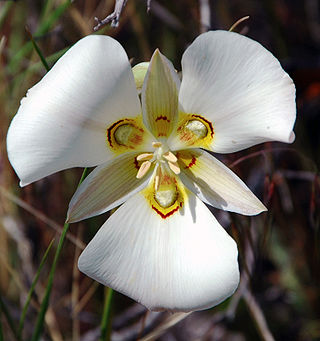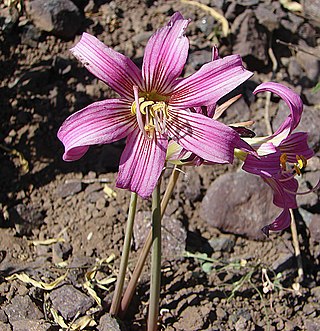
Melanthiaceae, also called the bunchflower family, is a family of flowering herbaceous perennial plants native to the Northern Hemisphere. Along with many other lilioid monocots, early authors considered members of this family to belong to the family Liliaceae, in part because both their sepals and petals closely resemble each other and are often large and showy like those of lilies, while some more recent taxonomists have placed them in a family Trilliaceae. The most authoritative modern treatment, however, the APG III system of 2009, places the family in the order Liliales, in the clade monocots. Circumscribed in this way, the family includes up to 17 genera.

Melanthieae is a tribe of flowering plants within the family Melanthiaceae. Molecular phylogenetic studies in the 21st century have resulted in a large-scale reassignment of many of its species to different genera; in particular the genus Zigadenus (deathcamases) has been restricted to a single species, Zigadenus glaberrimus. Plants contain alkaloids, making them unpalatable to grazing animals; many are very poisonous to both animals and humans.

Calochortus is a genus of flowering plants in the lily family. The group includes herbaceous, perennial and bulbous species, all native to North America.

Amianthium is a North American genus of perennial plants growing from bulbs. It contains the single known species Amianthium muscitoxicum, known in English as fly poison from a literal translation of the Latin epithet muscitoxicum, and is noted for its pretty flowers and its toxic alkaloid content. While all parts of the plant are poisonous, the bulb is particularly toxic. The scientific epithet was given to it by Thomas Walter when he published his Flora Caroliniana in 1788.

Toxicoscordion venenosum, with the common names death camas and meadow death camas, is a species of flowering plant in the genus Toxicoscordion, of the Melanthiaceae family. It is native to western North America from New Mexico to Saskatchewan and west to the Pacific Ocean.
Deathcamas or death camas refers to several species of flowering plant in the tribe Melanthieae. The name alludes to the great similarity of appearance between these toxic plants, which were formerly classified together in the genus Zigadenus, and the edible camases (Camassia), with which they also often share habitat. Other common names for these plants include deadly zigadene, hog potato and mystery-grass.

Schoenocaulon is a North American genus of perennial herbaceous flowering plants, ranging from the southern United States to Peru. It is a member of the Melanthiaceae, according to the APG III classification system, and is placed in the tribe Melanthieae. Unlike other genera in the tribe, the flowers are arranged in a spike; depending on the species the flower stalks for each flower are either very short or completely absent. Feathershank is a common name, the medicinally used S. officinale is called Sabadilla.

Toxicoscordion is a genus of flowering plants in the family Melanthiaceae, tribe Melanthieae, first described as a genus in 1903. The genus is mainly distributed in the midwestern United States and western North America, with some species in western Canada and northern Mexico.

Stenanthium is a North American genus of flowering plants in the tribe Melanthieae of the family Melanthiaceae.

Rhodolirium is a small South American genus in the tribe Hippeastreae of the family Amaryllidaceae. Although originally described by Philippi in 1858 it has long remained buried in other taxa, principally Hippeastrum and more recently Rhodophiala. Only in recent years has it been rehabilitated.

Zigadenus is a genus of flowering plants now containing only one species, Zigadenus glaberrimus, the sandbog death camas, found in the southeastern United States from Mississippi to Virginia. Around 20 species were formerly included in the genus, but have now been moved to other genera.

Lilioid monocots is an informal name used for a grade of five monocot orders in which the majority of species have flowers with relatively large, coloured tepals. This characteristic is similar to that found in lilies ("lily-like"). Petaloid monocots refers to the flowers having tepals which all resemble petals (petaloid). The taxonomic terms Lilianae or Liliiflorae have also been applied to this assemblage at various times. From the early nineteenth century many of the species in this group of plants were put into a very broadly defined family, Liliaceae sensu lato or s.l.. These classification systems are still found in many books and other sources. Within the monocots the Liliaceae s.l. were distinguished from the Glumaceae.

Stenanthium densum is a poisonous but spectacular monocot wildflower native to pine barrens of the eastern United States. It is known variously as Osceola's plume, crowpoison, or black snakeroot. Stenanthium leimanthoides is either treated as a synonym of this species or as a separate species. It is native to the southernmost Gulf Coast, from eastern Louisiana east, down through most of Florida, and to the easternmost Atlantic Coast north to Rhode Island, seldom far from the coast.

Stenanthium leimanthoides is a poisonous monocot wildflower native to acid montane areas of the eastern United States. It is either treated as a separate species to Stenanthium densum or as a synonym of that species. A common name is pine barren deathcamas.
Melanthium woodii, common names Wood's bunchflower or Ozark bunch-flower, is a species formerly known as Veratrum woodii. It is native to the central and southeastern parts of the United States, from Arkansas, Florida, Georgia, Illinois, Indiana, Iowa, Kentucky, Missouri, North Carolina, Ohio, Oklahoma and Tennessee. It can be found in forested areas at elevations less than 800 m.
Toxicoscordion fontanum, common name small-flower death camas, is a rare plant species known only from serpentine marshes in California. It is found primarily in the Coast Ranges from Mendocino County to San Luis Obispo County, with an additional report of an isolated population in the Sierra Nevada foothills in Kern County east of Bakersfield.

The taxonomy of the plant family Liliaceae has had a complex history since its first description in the mid-eighteenth century. Originally, the Liliaceae were defined as having a "calix" (perianth) of six equal-coloured parts, six stamens, a single style, and a superior, three-chambered (trilocular) ovary turning into a capsule fruit at maturity. The taxonomic circumscription of the family Liliaceae progressively expanded until it became the largest plant family and also extremely diverse, being somewhat arbitrarily defined as all species of plants with six tepals and a superior ovary. It eventually came to encompass about 300 genera and 4,500 species, and was thus a "catch-all" and hence paraphyletic. Only since the more modern taxonomic systems developed by the Angiosperm Phylogeny Group (APG) and based on phylogenetic principles, has it been possible to identify the many separate taxonomic groupings within the original family and redistribute them, leaving a relatively small core as the modern family Liliaceae, with fifteen genera and 600 species.

Phycella is a genus of herbaceous, perennial bulbous flowering plants belonging to the family Amaryllidaceae, subfamily Amaryllidoideae. The genus consists of five species distributed from central Chile to northwestern Argentina.

MelanthialesLink was an order of monocotyledons, whose name and botanical authority is derived by typification from the description of the type family, Melanthiaceae by Johann Heinrich Friedrich Link in 1829.















